Rick Just's Blog, page 103
January 29, 2022
Dispatches from the Past (tap to read)
Time for one of our occasional Dispatches from the Past where we feature oddities from newspapers that caught our eye while researching some unrelated topic.
From the August 8. 1867, Owyhee Bullion, an ad for the Poorman Saloon in Ruby City. “I have now opened a saloon in my own elegant styled building. I desire the patronage of those only WHO ARE LIABEL TO PAY.”
From the Idaho News, Blackfoot comes this light-hearted jab about the Grangeville paper on September 12, 1891. “The Free Press, published at Grangeville, has been as prompt to roll from the press on publication day as ‘Old Faithful’ the famous old geyser of the Yellowstone Park, is to throw up mud and water at its stated periods. But September 1st, Mrs. Parker honored her husband, the editor, as he was never honored before. She presented him with a daughter and that day the Free Press did not dance to the call nor the music. We are not kicking; editors should be allowed some privileges and daughter days are the times when allowances should come in. Next week we expect to see the Free Press bubbling over with sparkling gems of poesy, sentiment and songs about the little queen of the home empire.”
For context on this next one, you need to know that Idaho was a prohibition state beginning in 1916. Here’s a little blurb from the September 18, 1917 American Falls Press.
“Earl Fleming of the Bonanza Bar country was in town Friday night and somewhere in his travels picked up a bottle of the forbidden. He was in one of the pool halls and Deputy Sheriff Fred Walworth came in. Now you know Earl had known Fred a long time so he proffered the latter the bottle. Fred took the bottle all right, also the prisoner and Earl, after waiving his preliminary hearing, is awaiting under bond the session of the district court. Moral: don’t offer a sheriff a drink in a crowded pool hall.”
From the Blackfoot Idaho Republican, November 10, 1920.
“Because he had the Ford habit of getting out of his car when he wanted to start the engine, J.T. Burroughs, traveling salesman for an Idaho Falls wholesale grocery company, lost his Dodge car Saturday night, when it was struck at the crossing north of the depot by Short Line train No. 34, and barely escaped himself.”
The article went on to explain that the Dodge had stalled on the tracks, so Burroughs, out of habit, jumped out to crank the thing to a start. That’s when the train hit the car, which featured one of those new-fangled dashboard starters.
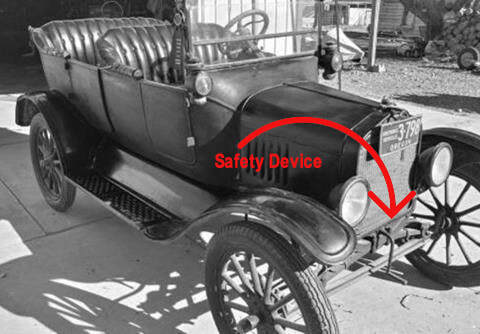
From the August 8. 1867, Owyhee Bullion, an ad for the Poorman Saloon in Ruby City. “I have now opened a saloon in my own elegant styled building. I desire the patronage of those only WHO ARE LIABEL TO PAY.”
From the Idaho News, Blackfoot comes this light-hearted jab about the Grangeville paper on September 12, 1891. “The Free Press, published at Grangeville, has been as prompt to roll from the press on publication day as ‘Old Faithful’ the famous old geyser of the Yellowstone Park, is to throw up mud and water at its stated periods. But September 1st, Mrs. Parker honored her husband, the editor, as he was never honored before. She presented him with a daughter and that day the Free Press did not dance to the call nor the music. We are not kicking; editors should be allowed some privileges and daughter days are the times when allowances should come in. Next week we expect to see the Free Press bubbling over with sparkling gems of poesy, sentiment and songs about the little queen of the home empire.”
For context on this next one, you need to know that Idaho was a prohibition state beginning in 1916. Here’s a little blurb from the September 18, 1917 American Falls Press.
“Earl Fleming of the Bonanza Bar country was in town Friday night and somewhere in his travels picked up a bottle of the forbidden. He was in one of the pool halls and Deputy Sheriff Fred Walworth came in. Now you know Earl had known Fred a long time so he proffered the latter the bottle. Fred took the bottle all right, also the prisoner and Earl, after waiving his preliminary hearing, is awaiting under bond the session of the district court. Moral: don’t offer a sheriff a drink in a crowded pool hall.”
From the Blackfoot Idaho Republican, November 10, 1920.
“Because he had the Ford habit of getting out of his car when he wanted to start the engine, J.T. Burroughs, traveling salesman for an Idaho Falls wholesale grocery company, lost his Dodge car Saturday night, when it was struck at the crossing north of the depot by Short Line train No. 34, and barely escaped himself.”
The article went on to explain that the Dodge had stalled on the tracks, so Burroughs, out of habit, jumped out to crank the thing to a start. That’s when the train hit the car, which featured one of those new-fangled dashboard starters.

Published on January 29, 2022 04:00
January 28, 2022
An Education or Trade for Every Boy or Girl (tap to read)
The Intermountain Institute in Weiser was a boarding school established in the fall of 1899 to provide children who lived too far from a high school a chance at an education. The school’s motto was “An education and trade for every boy and girl who is willing to work for them.” Children worked five hours a day to help pay for their tuition, board, and room.
About 2,000 students got their education there before the ravages of the Great Depression forced it to close in 1933.
To architects, one feature of the campus buildings is worth note. All but one of the structures, a carriage house, were made of reinforced cast concrete. Concrete was a common building material in early Idaho, but it was used mostly in block form.
The buildings at the Intermountain Institute still had some style. The surfaces of the neo-classical buildings were scored to resemble masonry joints. This can be seen in the photo below of the laundry building under construction.
The Weiser School District used campus buildings until 1967 when a new high school was built. Hooker Hall, a three-story building with a five-story clock tower, became the county museum in the 1980s. In 1994 a fire caused much damage, and the building is still under renovation.

About 2,000 students got their education there before the ravages of the Great Depression forced it to close in 1933.
To architects, one feature of the campus buildings is worth note. All but one of the structures, a carriage house, were made of reinforced cast concrete. Concrete was a common building material in early Idaho, but it was used mostly in block form.
The buildings at the Intermountain Institute still had some style. The surfaces of the neo-classical buildings were scored to resemble masonry joints. This can be seen in the photo below of the laundry building under construction.
The Weiser School District used campus buildings until 1967 when a new high school was built. Hooker Hall, a three-story building with a five-story clock tower, became the county museum in the 1980s. In 1994 a fire caused much damage, and the building is still under renovation.

Published on January 28, 2022 04:00
January 27, 2022
The Big Shiver (tap to read)
How cold was it? Well, they called the winter of 1887 and 1888 the Big Shiver in Idaho. The worst of it started on Friday the 13th, in January of 1888. Boise recorded 28 below that day. That record still stands, though it was tied on January 22, 1930. The mining camps and towns in the mountains estimated the temperature was 50 or 60 below.
Estimated? That was the best most could do. Mercury, the basis of the majority of thermometers at that time, freezes at 39 degrees. Young lads who had access to “quicksilver” found it entertaining to play marbles with frozen blobs of the stuff.*
Some intrepid weather trackers had spirit thermometers, which are alcohol based. One in Jordon Valley recorded 54 below.
Hundreds of cattle died along the Snake River. In Emmett, W.L. Fuller went out to milk his cow and found her frozen stiff, still standing.
The Idaho City World waxed poetic: “The kids of this place will regale the young generation of future years with tales of the awful cold weather in Boise County way back in ’88, and tell how the spirit thermometer registered down to the last degree, 99 below, and mercury froze on a red hot stove, and the kids played marbles with quicksilver.”
*Don’t try this at home. Mercury is highly toxic and handling is dangerous. Every. Single. One. Of those lads who played with quicksilver in 1888 is dead today.
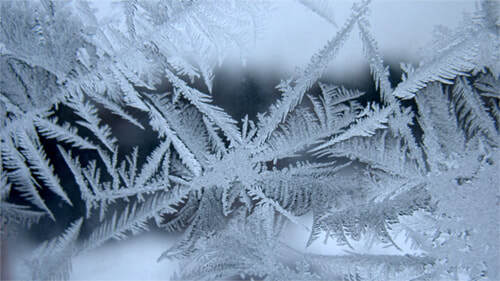
Estimated? That was the best most could do. Mercury, the basis of the majority of thermometers at that time, freezes at 39 degrees. Young lads who had access to “quicksilver” found it entertaining to play marbles with frozen blobs of the stuff.*
Some intrepid weather trackers had spirit thermometers, which are alcohol based. One in Jordon Valley recorded 54 below.
Hundreds of cattle died along the Snake River. In Emmett, W.L. Fuller went out to milk his cow and found her frozen stiff, still standing.
The Idaho City World waxed poetic: “The kids of this place will regale the young generation of future years with tales of the awful cold weather in Boise County way back in ’88, and tell how the spirit thermometer registered down to the last degree, 99 below, and mercury froze on a red hot stove, and the kids played marbles with quicksilver.”
*Don’t try this at home. Mercury is highly toxic and handling is dangerous. Every. Single. One. Of those lads who played with quicksilver in 1888 is dead today.

Published on January 27, 2022 04:00
January 26, 2022
Who's in the Doghouse Now? (tap to read)
Today’s post is about dogcatchers in Idaho history. It’s not a subject that gets a lot of attention, and this post will largely continue that tradition. I just did a word search through a couple of Idaho newspaper databases to see if anything interesting might come up.
I have more dogs than are strictly necessary (three). I keep them on leash, pick up after them, license them regularly, etc. So, this notice in the Idaho Statesman from June 10, 1911 caught my eye. It was datelined Nampa. “The dogcatcher is abroad in this city and acting under the mandates of the city council, urged to duty by the mayor and supported by the police department, a special officer has been detailed to enforce the law relative to taxation on dogs. The tax price is $3.50 for male and $5 for female dogs and any dog not wearing the tax collar will be summarily dispatched to happy hunting grounds after a short campaign in which each dog owner will have opportunity to pay up.”
This was apparently written in the days when it cost extra to insert an occasional period in a news story.
Several Idaho papers, including the Elmore Bulletin, carried a story about dogcatchers in Chicago in 1893. The short version is that they chased this big dog all over the city before finally capturing him and determining that he was a wolf.
The Wood River Times had a short opinion related to dogs and those who ought to catch them: “There are too many dogs in town for the public good. They annoy horsemen, teams and especially ladies on horseback, create disturbance with every strange dog visiting the town, keep peaceable people awake of nights, infest restaurants and public places, and are an intolerable nuisance. The dog-catchers should be started out.”
Stories about dogcatchers were often played for humor. In 1934 the Statesman ran the headline “Boise Mutts Yap Joyfully As Council Cans Dogcatcher.” It was a temporary budget move.
There were about as many stories intimating that someone couldn’t get elected dogcatcher as there were legitimate stories about dogcatchers. So, they may be able to catch dogs, but one thing dogcatchers can’t catch is a break.

I have more dogs than are strictly necessary (three). I keep them on leash, pick up after them, license them regularly, etc. So, this notice in the Idaho Statesman from June 10, 1911 caught my eye. It was datelined Nampa. “The dogcatcher is abroad in this city and acting under the mandates of the city council, urged to duty by the mayor and supported by the police department, a special officer has been detailed to enforce the law relative to taxation on dogs. The tax price is $3.50 for male and $5 for female dogs and any dog not wearing the tax collar will be summarily dispatched to happy hunting grounds after a short campaign in which each dog owner will have opportunity to pay up.”
This was apparently written in the days when it cost extra to insert an occasional period in a news story.
Several Idaho papers, including the Elmore Bulletin, carried a story about dogcatchers in Chicago in 1893. The short version is that they chased this big dog all over the city before finally capturing him and determining that he was a wolf.
The Wood River Times had a short opinion related to dogs and those who ought to catch them: “There are too many dogs in town for the public good. They annoy horsemen, teams and especially ladies on horseback, create disturbance with every strange dog visiting the town, keep peaceable people awake of nights, infest restaurants and public places, and are an intolerable nuisance. The dog-catchers should be started out.”
Stories about dogcatchers were often played for humor. In 1934 the Statesman ran the headline “Boise Mutts Yap Joyfully As Council Cans Dogcatcher.” It was a temporary budget move.
There were about as many stories intimating that someone couldn’t get elected dogcatcher as there were legitimate stories about dogcatchers. So, they may be able to catch dogs, but one thing dogcatchers can’t catch is a break.

Published on January 26, 2022 04:00
January 25, 2022
Idaho's First County. Sort of. (tap to read)
Which Idaho county was created first? That seems like a straightforward question, but history often has a dose of quirk.
Owyhee County was indisputably the first to be created by the Idaho Territorial Legislature in 1863. But Boise, Idaho, Nez Perce, and Shoshone were already counties when Idaho Territory was created. How so? They were created by the Washington Territorial Legislature when what we think of today as North Idaho was a part of that territory. Idaho lawmakers didn’t get around to officially recognizing them until 1864.
Owyhee County is big. Originally it was even bigger. The original county was all the land south of the Snake River and west of the Rockies. That lasted about a month before the Idaho Territorial Legislature took a big chunk of it for Oneida County. Today, puny little thing, Owyhee County is only the second largest county in the state at 7,697 square miles, behind Idaho County, which is 8,503 square miles. You could fit Rhode Island, Connecticut, and Washington DC into Owyhee County with 540 square miles to spare. But why would you want to? It would only irritate the jackrabbits.

Owyhee County was indisputably the first to be created by the Idaho Territorial Legislature in 1863. But Boise, Idaho, Nez Perce, and Shoshone were already counties when Idaho Territory was created. How so? They were created by the Washington Territorial Legislature when what we think of today as North Idaho was a part of that territory. Idaho lawmakers didn’t get around to officially recognizing them until 1864.
Owyhee County is big. Originally it was even bigger. The original county was all the land south of the Snake River and west of the Rockies. That lasted about a month before the Idaho Territorial Legislature took a big chunk of it for Oneida County. Today, puny little thing, Owyhee County is only the second largest county in the state at 7,697 square miles, behind Idaho County, which is 8,503 square miles. You could fit Rhode Island, Connecticut, and Washington DC into Owyhee County with 540 square miles to spare. But why would you want to? It would only irritate the jackrabbits.

Published on January 25, 2022 04:00
January 24, 2022
The Danger in Coca Cola (tap to read)
Things go better with… You finish the phrase. That’s right, things go better with history. Of Coca Cola.
Your great grandparents may not have enjoyed a Coke, but they certainly had the opportunity. Coca Cola began appearing in advertising in the Idaho Statesman in 1896. The drink had been invented in 1886 by pharmacist John Pemberton. The beverage’s inventor knew nothing about marketing, so didn’t do especially well with his drink. It was Asa Griggs Candler who took over the company and made it work, first advertising Coca Cola as a patent medicine that would get rid of fatigue and headaches.
And, yes, early version of Coca Cola did contain a trace of cocaine, which was a common patent medicine ingredient. In 1907, the Idaho Pure Food Commission did an analysis of “the popular soda drink called Coca Cola.” A story in the Statesman said the commission had found no cocaine, but, “While this is not to be classed with as dangerous drug as cocaine, it is not one which can be recommended for constant us. A glass of Coca Cola, as ordinarily served at soda fountains, contains about one grain of caffeine.”
The Women’s Christian Temperance Union wasn’t convinced. A 1908 Idaho Statesman article noted that a WCTU meeting had been about the danger of drinking Coca Cola. “Mrs. McIntyre reading from various sources descriptive of this evil. These articles claim that in spite of the requirements of the new pure food law, this beverage still contains injurious quantities of cocaine.”
The WCTU had better luck, for a time, with prohibition of alcohol. Coca Cola went on to be a somewhat popular drink in Idaho and every other corner of the earth.
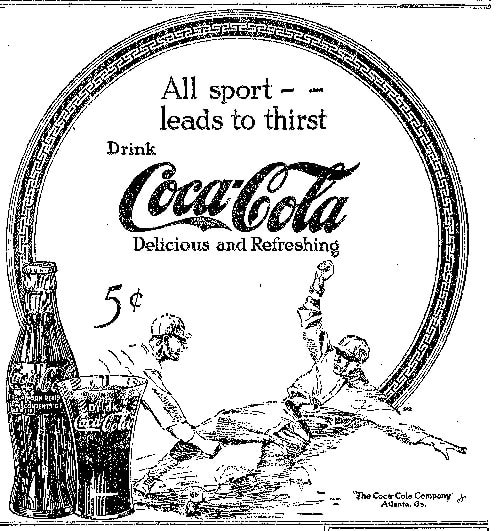
Your great grandparents may not have enjoyed a Coke, but they certainly had the opportunity. Coca Cola began appearing in advertising in the Idaho Statesman in 1896. The drink had been invented in 1886 by pharmacist John Pemberton. The beverage’s inventor knew nothing about marketing, so didn’t do especially well with his drink. It was Asa Griggs Candler who took over the company and made it work, first advertising Coca Cola as a patent medicine that would get rid of fatigue and headaches.
And, yes, early version of Coca Cola did contain a trace of cocaine, which was a common patent medicine ingredient. In 1907, the Idaho Pure Food Commission did an analysis of “the popular soda drink called Coca Cola.” A story in the Statesman said the commission had found no cocaine, but, “While this is not to be classed with as dangerous drug as cocaine, it is not one which can be recommended for constant us. A glass of Coca Cola, as ordinarily served at soda fountains, contains about one grain of caffeine.”
The Women’s Christian Temperance Union wasn’t convinced. A 1908 Idaho Statesman article noted that a WCTU meeting had been about the danger of drinking Coca Cola. “Mrs. McIntyre reading from various sources descriptive of this evil. These articles claim that in spite of the requirements of the new pure food law, this beverage still contains injurious quantities of cocaine.”
The WCTU had better luck, for a time, with prohibition of alcohol. Coca Cola went on to be a somewhat popular drink in Idaho and every other corner of the earth.

Published on January 24, 2022 04:00
January 23, 2022
The Old Bingham County Courthouse (tap to read)
We’ve all had that feeling. The, “wait, it couldn’t have been that long ago” feeling. I get that sense when I drive by Courthouse Square in Blackfoot. It's a nice little park with a fountain that local delinquents enjoy pouring soap into on a regular basis.
But it wasn’t always a park. It was the site of the Bingham County Courthouse (picture), built in 1885. It was remodeled in 1956, which was about the time I would have started riding down Shilling Avenue past it with my mother, the “egg lady,” on her delivery rounds. I started driving past it myself in 1964 when I got my first driver’s license there at age 14.
The two-story building was something of an Italianate style with its bracketed eaves, segmental window arches, and cubical massing, all resting on a lava rock foundation. It served the needs of Bingham County for about a hundred years. The building was demolished in 1987. A new courthouse was built across town.
Shilling Avenue in Blackfoot is named after early pioneer Watson N. Shilling. He was instrumental in securing the authority for the railroad to cross the Fort Hall Indian Reservation in 1878.
This post uses information from a booklet called “The Historic Shilling District” published by the Bingham County Historical Society.
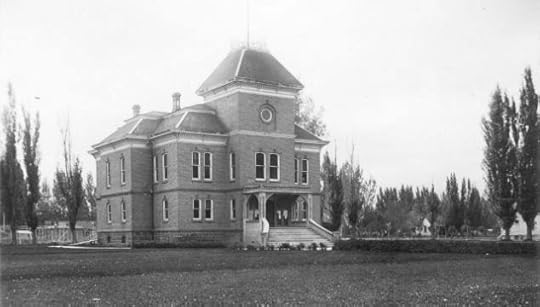
But it wasn’t always a park. It was the site of the Bingham County Courthouse (picture), built in 1885. It was remodeled in 1956, which was about the time I would have started riding down Shilling Avenue past it with my mother, the “egg lady,” on her delivery rounds. I started driving past it myself in 1964 when I got my first driver’s license there at age 14.
The two-story building was something of an Italianate style with its bracketed eaves, segmental window arches, and cubical massing, all resting on a lava rock foundation. It served the needs of Bingham County for about a hundred years. The building was demolished in 1987. A new courthouse was built across town.
Shilling Avenue in Blackfoot is named after early pioneer Watson N. Shilling. He was instrumental in securing the authority for the railroad to cross the Fort Hall Indian Reservation in 1878.
This post uses information from a booklet called “The Historic Shilling District” published by the Bingham County Historical Society.

Published on January 23, 2022 04:00
January 22, 2022
The Mikado is Alway Showing in Boise (tap to read)
One of the most common locomotive engines during the heyday of steam was the Mikado. It was called the Mikado because many of the first engines were built for export to Japan. Railroad workers nicknamed the Mikados “Mike.” That’s why the one on display at the Boise Depot is called Big Mike.
They were giants. Big Mike is almost 82 feet long, counting its tender. It’s 15 feet 10 3/8 inches from the ground to the top of the stack, and the whole thing weighs 463,000 pounds before it takes on up to 17 tons of coal and 10,000 gallons of water.
They built the 14,000 Mikados from 1911 through 1944. Big Mike is a Mikado 282, which means it has eight big wheels underneath the locomotive with two smaller wheels in front and two in back.
Big Mike, or Engine No. 2295, was retired by Union Pacific and donated to the city of Boise in 1956. The locomotive was subsequently moved to the 3rd Street entrance to Julia Davis Park.
On Dec. 9, 2007, Big Mike—minus its tender—was moved to a new home on a siding east of the Boise Depot. Hundreds of people watched the move, which occurred at midnight on a cold winter's night. The tender, which carried water and fuel for the engine, was separated from the engine and had been moved on Dec. 6, 2007.
It’s well worth visiting the Boise Depot and Big Mike if you haven’t already done so.
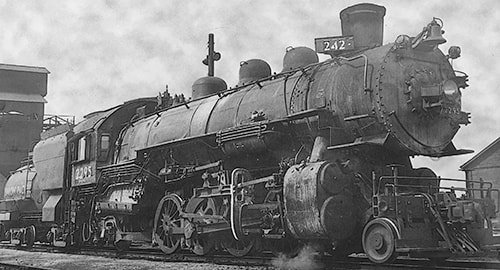
They were giants. Big Mike is almost 82 feet long, counting its tender. It’s 15 feet 10 3/8 inches from the ground to the top of the stack, and the whole thing weighs 463,000 pounds before it takes on up to 17 tons of coal and 10,000 gallons of water.
They built the 14,000 Mikados from 1911 through 1944. Big Mike is a Mikado 282, which means it has eight big wheels underneath the locomotive with two smaller wheels in front and two in back.
Big Mike, or Engine No. 2295, was retired by Union Pacific and donated to the city of Boise in 1956. The locomotive was subsequently moved to the 3rd Street entrance to Julia Davis Park.
On Dec. 9, 2007, Big Mike—minus its tender—was moved to a new home on a siding east of the Boise Depot. Hundreds of people watched the move, which occurred at midnight on a cold winter's night. The tender, which carried water and fuel for the engine, was separated from the engine and had been moved on Dec. 6, 2007.
It’s well worth visiting the Boise Depot and Big Mike if you haven’t already done so.

Published on January 22, 2022 04:00
January 21, 2022
If it Weren't for Bad Luck... (tap to read)
Luck seems to find its way in to talk about mining, perhaps more than any endeavor other than gambling. Prospectors chased the easy riches of the lucky even while performing back-breaking work. Mine names reflected this: Lucky Friday, Lucky Boy, Lucky Lager, Lucky Seven, Lucky Jim, and on and on.
Two mining towns in Idaho were decidedly unlucky. There were productive mines associated with them, and some miners found their fortunes. But the towns themselves, Burke and Mace, about 3.5 miles north of Mullan and a quarter-mile apart, each had a double dose of bad luck.
On February 27, 1890, 16 people died when a midnight snowslide 3000 feet long and 75 feet deep buried the Mace, Idaho.
Mrs. R.H. Pasco heard the rumble of the slide and sat up in bed, wondering what was going on. Then, the mountain of snow hit, flipping her bed on its side and pinning her beneath it up against the wall. Rescuers found her pinned beneath the twisted bed frame, the only survivor of her family of four.
Mrs. George Gibson owed her life to a man who saw a single finger protruding above the snow. After being buried alive for more than an hour, rescuers dug her out, half-frozen.
It was the second fatal slide of the month. Earlier, two men were killed on the outskirts of town when chinook winds destabilized the mountainside snow, causing a slide that engulfed their tents.
Thirty years later to the day, on February 27, 1910, a monster slide struck Mace again. That was just before midnight. The next dark morning, a second avalanche roared through Burke. The combined death toll in the two towns was 20. Among them were three residents of Burke who had spent the night helping to rescue people from the Mace slide, only to be buried by the Burke avalanche when they got back home.
The Burke Canyon, where both towns sat, is steep-sided enough for it to get a mention in Ripley’s Believe it or Not. The canyon is so narrow there is barely room for a street. A railroad spur and Canyon Creek ran in a tunnel between two parts of the Tiger Hotel. No wonder the area was prone to avalanches.
Burke and Mace shared at least one more disaster. In 1923, a spark from a passing train caught the roof of a house on fire in Mace. The fire spread from building to building, taking out most of Mace and much of Burke.
So, double lousy luck, at least, for these mining towns. But calamity had long loomed on the sides of the mountains above them. Bad luck often visits those who tempt fate.
 Three people met their death in this house during the 1910 avalanche. This photo appeared in Frank Leslie’s Weekly, March 24, 1910.
Three people met their death in this house during the 1910 avalanche. This photo appeared in Frank Leslie’s Weekly, March 24, 1910.
[image error] The train tracks went through the Tiger Hotel in Burke. Lodgers had to close their windows when smoking trains came through quickly. The hotel was demolished in the 1950s.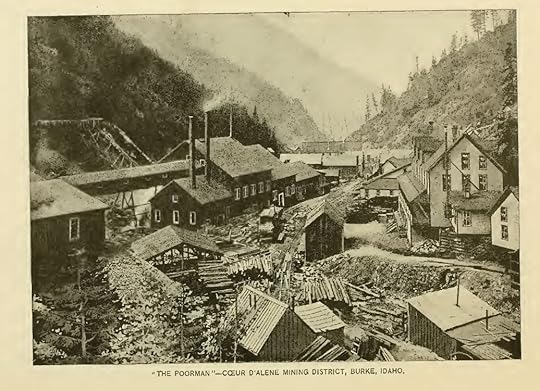 Burke, Idaho in 1890.
Burke, Idaho in 1890.
Two mining towns in Idaho were decidedly unlucky. There were productive mines associated with them, and some miners found their fortunes. But the towns themselves, Burke and Mace, about 3.5 miles north of Mullan and a quarter-mile apart, each had a double dose of bad luck.
On February 27, 1890, 16 people died when a midnight snowslide 3000 feet long and 75 feet deep buried the Mace, Idaho.
Mrs. R.H. Pasco heard the rumble of the slide and sat up in bed, wondering what was going on. Then, the mountain of snow hit, flipping her bed on its side and pinning her beneath it up against the wall. Rescuers found her pinned beneath the twisted bed frame, the only survivor of her family of four.
Mrs. George Gibson owed her life to a man who saw a single finger protruding above the snow. After being buried alive for more than an hour, rescuers dug her out, half-frozen.
It was the second fatal slide of the month. Earlier, two men were killed on the outskirts of town when chinook winds destabilized the mountainside snow, causing a slide that engulfed their tents.
Thirty years later to the day, on February 27, 1910, a monster slide struck Mace again. That was just before midnight. The next dark morning, a second avalanche roared through Burke. The combined death toll in the two towns was 20. Among them were three residents of Burke who had spent the night helping to rescue people from the Mace slide, only to be buried by the Burke avalanche when they got back home.
The Burke Canyon, where both towns sat, is steep-sided enough for it to get a mention in Ripley’s Believe it or Not. The canyon is so narrow there is barely room for a street. A railroad spur and Canyon Creek ran in a tunnel between two parts of the Tiger Hotel. No wonder the area was prone to avalanches.
Burke and Mace shared at least one more disaster. In 1923, a spark from a passing train caught the roof of a house on fire in Mace. The fire spread from building to building, taking out most of Mace and much of Burke.
So, double lousy luck, at least, for these mining towns. But calamity had long loomed on the sides of the mountains above them. Bad luck often visits those who tempt fate.
 Three people met their death in this house during the 1910 avalanche. This photo appeared in Frank Leslie’s Weekly, March 24, 1910.
Three people met their death in this house during the 1910 avalanche. This photo appeared in Frank Leslie’s Weekly, March 24, 1910. [image error] The train tracks went through the Tiger Hotel in Burke. Lodgers had to close their windows when smoking trains came through quickly. The hotel was demolished in the 1950s.
 Burke, Idaho in 1890.
Burke, Idaho in 1890.
Published on January 21, 2022 04:00
January 20, 2022
The Overland Stage (tap to read)
Stagecoaches are an icon of Westerns. They were always getting robbed and occasionally attacked by Indians. Unlike six-gun duels in the street, which were largely an invention of dime novels, stagecoaches deserve their icon status.
The best known and most successful of the stagecoach companies was the Overland Stage. Stagecoaches brought passengers and supplies, but their most important cargo was mail. Ben Holladay, who ran the company, had the US Mail contract which brought him more than a million dollars a year for a time. He built a mansion in Washington, DC just so he could lobby Congress for contracts.
Running a stage line was profitable, but it was also expensive and complicated. Holladay had to set up stage stations every 10 to 15 miles along his routes. The one that ran through Idaho started in Kansas. The stations had vast stores of shelled corn for the horses and men to take care of the animals. The Overland Stage could boast the capability of moving along at 100 miles a day, by rolling day and night. There were frequent delays, like the ones that ended up in the movies.
Newspapers depended on the arrival of other newspapers from across the country to supplement their local editions. On August 2, 1864, the Idaho Tri-Weekly Statesman published a story under the standing head By Overland Stage. It explained the delay in getting news from the company by listing some of the issues coaches had run into in recent days. About 100 miles out of Denver Indians had stolen all the Overland Stage Livestock. A stage near Fort Bridger, Wyoming had also been stopped by Indians. A third stage was attacked near Platte Bridge.
The coaches were comfortable when compared with walking. All the Overland Stages were built on a standard pattern called The Concord Coach. They had heavy leather springs and were pulled by four or six horses. Passengers piled in and piled on. The company was all about profit, so they didn’t necessarily go on a schedule. They would often wait until a stage was full of people and supplies. The picture shows a stagecoach (perhaps not an Overland) on a road along the Snake River Canyon near Twin Falls. It is one of the Idaho State Historical Society’s photos from the Bisbee collection.
As important as they were, stagecoaches roamed the West for a fairly short time. The Overland Stage Company, which made Holladay a fortune, lasted about ten years. Holladay transitioned to railroads, which is the way the mail went. He lost most of his fortune trying to run trains.
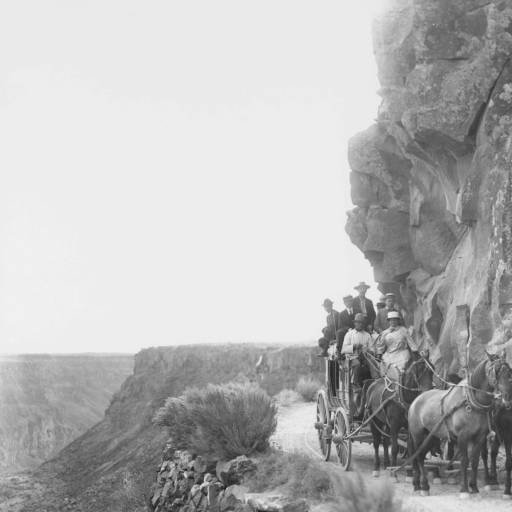
The best known and most successful of the stagecoach companies was the Overland Stage. Stagecoaches brought passengers and supplies, but their most important cargo was mail. Ben Holladay, who ran the company, had the US Mail contract which brought him more than a million dollars a year for a time. He built a mansion in Washington, DC just so he could lobby Congress for contracts.
Running a stage line was profitable, but it was also expensive and complicated. Holladay had to set up stage stations every 10 to 15 miles along his routes. The one that ran through Idaho started in Kansas. The stations had vast stores of shelled corn for the horses and men to take care of the animals. The Overland Stage could boast the capability of moving along at 100 miles a day, by rolling day and night. There were frequent delays, like the ones that ended up in the movies.
Newspapers depended on the arrival of other newspapers from across the country to supplement their local editions. On August 2, 1864, the Idaho Tri-Weekly Statesman published a story under the standing head By Overland Stage. It explained the delay in getting news from the company by listing some of the issues coaches had run into in recent days. About 100 miles out of Denver Indians had stolen all the Overland Stage Livestock. A stage near Fort Bridger, Wyoming had also been stopped by Indians. A third stage was attacked near Platte Bridge.
The coaches were comfortable when compared with walking. All the Overland Stages were built on a standard pattern called The Concord Coach. They had heavy leather springs and were pulled by four or six horses. Passengers piled in and piled on. The company was all about profit, so they didn’t necessarily go on a schedule. They would often wait until a stage was full of people and supplies. The picture shows a stagecoach (perhaps not an Overland) on a road along the Snake River Canyon near Twin Falls. It is one of the Idaho State Historical Society’s photos from the Bisbee collection.
As important as they were, stagecoaches roamed the West for a fairly short time. The Overland Stage Company, which made Holladay a fortune, lasted about ten years. Holladay transitioned to railroads, which is the way the mail went. He lost most of his fortune trying to run trains.

Published on January 20, 2022 04:00



